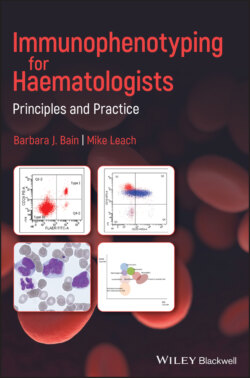Читать книгу Immunophenotyping for Haematologists - Barbara J. Bain, Irene Roberts - Страница 7
Part 1 Purpose and Principles of Immunophenotyping CONTENTS
ОглавлениеFlow Cytometric Immunophenotyping
Immunohistochemistry
Interpretation and Limitations of Flow Cytometric Immunophenotyping
Problems and Pitfalls
References
Bibliography
Immunophenotyping is the process by which the pattern of expression of antigens by a population of cells is determined. The presence of a specific antigen is recognised by its binding to a labelled antibody. Antibodies can be present in a polyclonal antiserum that is raised in an animal but more often they are well characterised monoclonal antibodies produced by hybridoma technology; a hybridoma is a clone of cells created by the fusion of an antibody‐producing cell with a mouse myeloma cell. Monoclonal antibodies can be labelled with an enzyme or with a chemical, known as a fluorochrome, that under certain circumstances will fluoresce. Immunophenotyping is carried out primarily by flow cytometry or immunohistochemistry. Flow cytometric immunophenotyping is applicable to cells in peripheral blood, bone marrow, body fluids (pleural, pericardial, ascitic and cerebrospinal fluids) and fine needle aspirates. Immunohistochemistry of relevance to haematological disease is applied particularly to trephine biopsy and lymph node biopsy specimens, but also to biopsy specimens from any other tissues where infiltration by haemopoietic or lymphoid cells is suspected.
